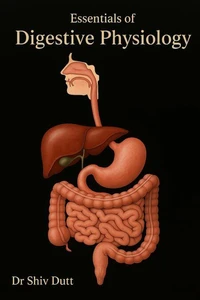The cardiovascular system is the central engine of human life, driving circulation, maintaining homeostasis, and adapting to stress and disease. This book provides a comprehensive yet concise account of cardiovascular physiology, covering everything from the basic anatomy of the heart and blood vessels to the complex regulation of cardiac output, blood pressure, and regional circulation. Special attention is given to clinical correlations such as heart sounds, ECG interpretation, arrhythmias, heart failure, shock, hypertension, and the physiology of exercise.
Designed as a handbook-style resource, it is ideal for medical, dental, nursing, and allied health students preparing for examinations as well as for practitioners needing a quick refresher. By the end of this book, readers will: Understand the structure and function of the heart, vessels, and conduction system. Learn how the cardiac cycle, heart sounds, and ECG reflect physiology in action. Explore the mechanisms of cardiovascular regulation including Starling's law, autonomic influences, and RAAS.
Gain insight into regional circulations like coronary, cerebral, pulmonary, hepatic, renal, and fetal. Apply physiology to clinical settings such as arrhythmias, hypertension, hemorrhage, and exercise adaptation. Table of Contents(as per your index) Cardiovascular System Anatomy of the Heart Valves of the Heart Arterioles Capillaries Sinusoids (Sinusoidal Capillaries) Veins Special Junctional Tissues of the Heart 1.
Sinoatrial (SA) Node 2. Atrioventricular (AV) Node 3. Bundle of His (Atrioventricular Bundle) 4. Purkinje Fibers Properties of Cardiac Muscle - Excitability - Rhythmicity (Autorhythmicity) - Pacemaker of the Heart (SA Node) - Cardiac Action Potentials (Fast & Slow Response) - Conduction of Cardiac Impulse - Contractility of Cardiac Muscle - Refractory Period Origin of the Heartbeat Apex Beat (Ictus Cordis / Apical Impulse) Heart Block Cardiac Cycle - Atrial Events - Ventricular Events - Sequence of Events - Pressure & Volume Changes - Jugular Venous Pulse - Composite Representation Heart Sounds - First (S1), Second (S2), Third (S3), Fourth (S4) - Murmurs (Systolic, Diastolic, Continuous) Electrocardiography (ECG) - Leads, Einthoven's Triangle - Normal & Abnormal ECG - Intervals, Segments, Axis - ECG in Disorders (Arrhythmias, IHD, Electrolyte Changes) Nerves of the Heart & CNS Control Heart Rate & Its Regulation Arrhythmias & Abnormal Pacemakers Cardiac Output & Starling's Law Blood Pressure & Its Regulation (Short-, Intermediate-, Long-term) Hemodynamics & Vascular Resistance Arterial Pulse & Venous Pulse Regional Circulation - Coronary, Cerebral, Pulmonary, Hepatic, Splenic, Renal, Cutaneous, Skeletal Muscle - Capillary Exchange & Starling Forces - Fetal Circulation & Birth Changes Applied Cardiovascular Physiology - Hemorrhage - Heart Failure - Hypotension & Hypertension - Shock (Stages & Management) Exercise & Work Physiology - Cardiovascular & Respiratory Adaptations - Oxygen Exchange - Fluid & Hormonal Changes - Endurance Training, Benefits, Over-exercising
The cardiovascular system is the central engine of human life, driving circulation, maintaining homeostasis, and adapting to stress and disease. This book provides a comprehensive yet concise account of cardiovascular physiology, covering everything from the basic anatomy of the heart and blood vessels to the complex regulation of cardiac output, blood pressure, and regional circulation. Special attention is given to clinical correlations such as heart sounds, ECG interpretation, arrhythmias, heart failure, shock, hypertension, and the physiology of exercise.
Designed as a handbook-style resource, it is ideal for medical, dental, nursing, and allied health students preparing for examinations as well as for practitioners needing a quick refresher. By the end of this book, readers will: Understand the structure and function of the heart, vessels, and conduction system. Learn how the cardiac cycle, heart sounds, and ECG reflect physiology in action. Explore the mechanisms of cardiovascular regulation including Starling's law, autonomic influences, and RAAS.
Gain insight into regional circulations like coronary, cerebral, pulmonary, hepatic, renal, and fetal. Apply physiology to clinical settings such as arrhythmias, hypertension, hemorrhage, and exercise adaptation. Table of Contents(as per your index) Cardiovascular System Anatomy of the Heart Valves of the Heart Arterioles Capillaries Sinusoids (Sinusoidal Capillaries) Veins Special Junctional Tissues of the Heart 1.
Sinoatrial (SA) Node 2. Atrioventricular (AV) Node 3. Bundle of His (Atrioventricular Bundle) 4. Purkinje Fibers Properties of Cardiac Muscle - Excitability - Rhythmicity (Autorhythmicity) - Pacemaker of the Heart (SA Node) - Cardiac Action Potentials (Fast & Slow Response) - Conduction of Cardiac Impulse - Contractility of Cardiac Muscle - Refractory Period Origin of the Heartbeat Apex Beat (Ictus Cordis / Apical Impulse) Heart Block Cardiac Cycle - Atrial Events - Ventricular Events - Sequence of Events - Pressure & Volume Changes - Jugular Venous Pulse - Composite Representation Heart Sounds - First (S1), Second (S2), Third (S3), Fourth (S4) - Murmurs (Systolic, Diastolic, Continuous) Electrocardiography (ECG) - Leads, Einthoven's Triangle - Normal & Abnormal ECG - Intervals, Segments, Axis - ECG in Disorders (Arrhythmias, IHD, Electrolyte Changes) Nerves of the Heart & CNS Control Heart Rate & Its Regulation Arrhythmias & Abnormal Pacemakers Cardiac Output & Starling's Law Blood Pressure & Its Regulation (Short-, Intermediate-, Long-term) Hemodynamics & Vascular Resistance Arterial Pulse & Venous Pulse Regional Circulation - Coronary, Cerebral, Pulmonary, Hepatic, Splenic, Renal, Cutaneous, Skeletal Muscle - Capillary Exchange & Starling Forces - Fetal Circulation & Birth Changes Applied Cardiovascular Physiology - Hemorrhage - Heart Failure - Hypotension & Hypertension - Shock (Stages & Management) Exercise & Work Physiology - Cardiovascular & Respiratory Adaptations - Oxygen Exchange - Fluid & Hormonal Changes - Endurance Training, Benefits, Over-exercising

 , qui est-ce ?
, qui est-ce ?